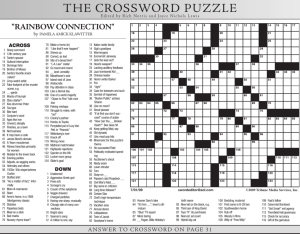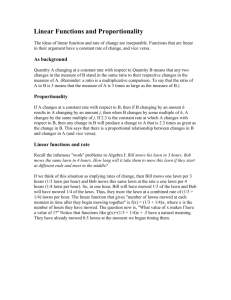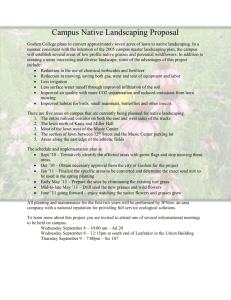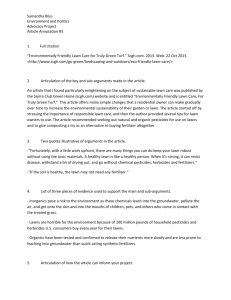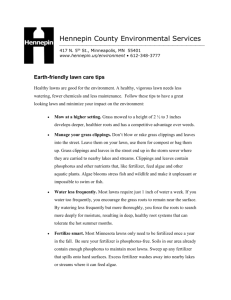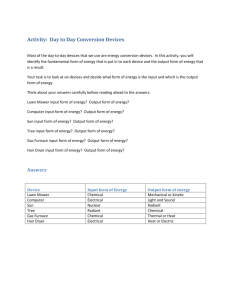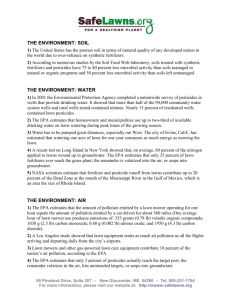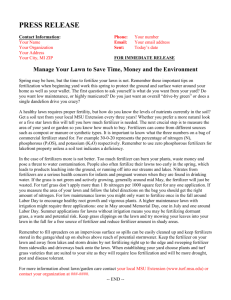History of the Lawn Care Industry Robert Earley, Editor Lawn Care
advertisement
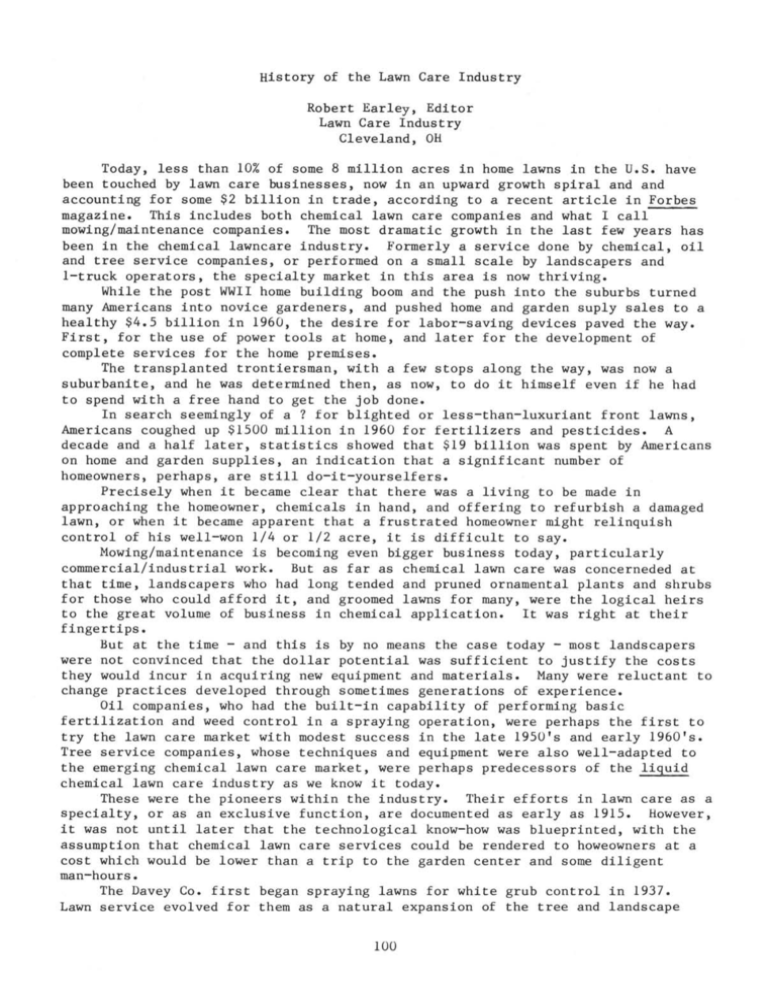
History of the Lawn Care Industry Robert Earley, Editor Lawn Care Industry Cleveland, OH Today, less than 10% of some 8 million acres in home lawns in the U.S. have been touched by lawn care businesses, now in an upward growth spiral and and accounting for some $2 billion in trade, according to a recent article in Forbes magazine. This includes both chemical lawn care companies and what I call mowing/maintenance companies. The most dramatic growth in the last few years has been in the chemical lawncare industry. Formerly a service done by chemical, oil and tree service companies, or performed on a small scale by landscapers and I-truck operators, the specialty market in this area is now thriving. While the post WWII home building boom and the push into the suburbs turned many Americans into novice gardeners, and pushed home and garden suply sales to a healthy $4.5 billion in 1960, the desire for labor-saving devices paved the way. First, for the use of power tools at home, and later for the development of complete services for the home premises. The transplanted trontiersman, with a few stops along the way, was now a suburbanite, and he was determined then, as now, to do it himself even if he had to spend with a free hand to get the job done. In search seemingly of a ? for blighted or less-than-luxuriant front lawns, Americans coughed up $1500 million in 1960 for fertilizers and pesticides. A decade and a half later, statistics showed that $19 billion was spent by Americans on home and garden supplies, an indication that a significant number of homeowners, perhaps, are still do-it-yourselfers. Precisely when it became clear that there was a living to be made in approaching the homeowner, chemicals in hand, and offering to refurbish a damaged lawn, or when it became apparent that a frustrated homeowner might relinquish control of his well-won 1/4 or 1/2 acre, it is difficult to say. MOWing/maintenance is becoming even bigger business today, particularly commercial/industrial work. But as far as chemical lawn care was concerneded at that time, landscapers who had long tended and pruned ornamental plants and shrubs for those who could afford it, and groomed lawns for many, were the logical heirs to the great volume of business in chemical application. It was right at their fingertips. But at the time - and this is by no means the case today - most landscapers were not convinced that the dollar potential was sufficient to justify the costs they would incur in acquiring new equipment and materials. Many were reluctant to change practices developed through sometimes generations of experience. Oil companies, who had the built-in capability of performing basic fertilization and weed control in a spraying operation, were perhaps the first to try the lawn care market with modest success in the late 1950's and early 1960's. Tree service companies, whose techniques and equipment were also well-adapted to the emerging chemical lawn care market, were perhaps predecessors of the liquid chemical lawn care industry as we know it today. These were the pioneers within the industry. Their efforts in lawn care as a specialty, or as an exclusive function, are documented as early as 1915. However, it was not until later that the technological know-how was blueprinted, with the assumption that chemical lawn care services could be rendered to howeowners at a cost which would be lower than a trip to the garden center and some diligent man-hours. The Davey Co. first began spraying lawns for white grub control in 1937. Lawn service evolved for them as a natural expansion of the tree and landscape 100 servicest and by the early '60'st Davey was providing lawn fertilization and insect and weed control as part of their total plant care program. It was nott howevert until 1974 that a separate division-Davey Lawnscape-was established to meet the growing demand for lawn services. In the spring of 1951t a young man from Peoria also got the idea that fertilizer could be sprayed on lawns in liquid form. He started testing his hypothesis on his own lawn with a common water sprinkling can. The man was C. Milliard DailYt and his company-Liqui-Green Lawn Spraying-is still very successful today. Another prolific dreamer was a kid from Brooklyn who though that somehow he could apply the principles of farm technology to lawn caret thereby dramatically cutting labor costs and rendering efficient service to the homeowner. After some experimenting in the mid-1950'st Daniel Dorfman perfected the design for a machine capable of simultaneously rollingt fertilizingt applying pesticides, aerating and seeding a lawn in one pass with a relatively unskilled operator at the controls (kind of a tractort pulled by a combine that distributed dry materials). The result was a Lawn-A-Matt incorporated in 1961, which became a prototype for many of the lawn care services that cropped up in high densities on Long Island in New Yorkt and more generally in the Boston-Washington corridor in the following decade. Dorfman Began selling franchises for his Lawn-A-Mat in 1962 and found enough takers to take on some 300 franchises by 1967t with an average volume of $75tOOO/dealer at that time ($20tOOO-400,000). The franchisers spread it over the country. But as in many stories of phenomenal success, growth created some problems. Dorfman is no longer a young mant has moved from Brooklyn to fashionable Long Islandt and spends a good deal of his time these days with lawyers and franchiser lawyers. But although there have been some problems along the waYt his company still thrives today. Spin-offs of Lawn-A-Mat include Lawn Doctort whose foundert Tony Giordanot is a former franchiser of Lawn-A-Mat and was also a franchiser of another firm, Lawn King. And the president of Lawn Kingt Joe San?t is also a former Lawn-A-Mat franchiser. But these and other franchisers are by no means doing all of the business in lawn care. Lawn spraying also began in Michigan in the early '50's with companies like Fertilize and others. The market has grown substantially in this state and now has one of the healthiest comcentrations of independent chemical lawn care companies in the countrYt along with some of the majors such as Tru-Greent based right in this area. L.S.A. of Michigant formed in 1974t now has 65 members - one of three. I think the rest of the country could learn a lot about chemical lawn care by just spending some time with people in this roomt who are some of the pioneers of ???? ChemLawnt the thoroughbred of the industrYt began a slow, measured-growth endeavor in lawn care in 1969. The founder - Dick Duke - had been in the nursery business in TroYt Ohio with his fathert and sod was a big part of their business. They began to find that homeowners they installed sod for in the burgeoning new home developments were asking for advicet and in many cases, were asking the Dukes to handle fertilization and pest control on their lawns. On a company-owned basis, ChemLawn opened branches one-by-one across the country and looked to a personlizedt on-call service program to build business. Headquarted in Columbus, Ohio, the company now has well over 120 branchest almost 2tOOO employeest and grossed $86 million last year. They had 675,000 customers and treated 130,000 acres of lawns. As you knowt most of their business is done in liquid spray application form. Dick Duke and his father sold stock literally door-to-door in the early dayst most of the time to customers. The value of their stock has grown tremendously. Late last yeart it was selling on the market for close to $40 per share. It splitt and two weeks latert it was up 101 again to $36 per share. Many other companies have followed in the 1970's. The lawn care industry was pretty much of an industry of the 1970's in terms of growth, although the beginnings of it can be traced back before that. We can look for even more growth in the 1980's, but perhaps not as rapid as in the 1970's. But this kind of sensible growth goes along with professional industries. The lawn care industry is more than just lawn care, but the phenomenal growth of the chemical segment has put a focus on the total lawn care industry in general, and provided growth for everybody. Our magazine did a survey last year on the readership of Lawn Care Industry--a magazine which has subscribers about 55% maintenance companies and about 45% chemical lawn care companies. Our results were 47% sole propiretorships, 37% independent corporations, 11% partnerships, 4$ franchises and 1% company-owned chains. The average number of accounts was 478, 89% of which were under contract which calls for more than one visit. Also, 91% of accounts are residential. 7.1% of single family, owner occupied homes are served by readers of Lawn Care Industry, based on government statistics. Gross receipts in 1978 for maintenance or chemical services were $100,915 per company. The percentage of gross receipts was 34% for mowing, 14% from dry applied fertilizer, 10% from insect control, 8% from weed control, 7% from liquid fertilizers and 4% from other sources. Among equipment inventory 79% had walk behind rotary mowers and 29% reel mowers. Among riding mowers, 55% had rotary and 15% reel. 86% used granular applicators, 68% used seeders, 57% dethatchers, 47% aerators; 93% used pick-up trucks. Twenty six percent had less than 10 horsepower tractors, 45% 10-20 horsepower, 20% 21-30 horsepower, 25% 31-50 horsepower and 20% larger than 50 horsepower tractors. 72% used less than 500 gallon tanks, 21% used 500-1200 gallon tanks and 4$ were over 1200 gallons. Among annual purchases, 82% bought grass seed, 97% fertilizer, 83% insecticides, 80% herbicides, 61% fungicides, 28% riding mowers. Among advertising, 58% used the yellow pages, 42% newspapers, 27% personal solicitations, 19% direct mail, 18% telephone contacts, 16% radio, 12% door hangers and 6% television. Among the chemical application companies, 4 visits or more were 40%, 5 visits were 22%, 6 visits were 15% and 3 visits were 14%. Growth of the industry has been 20-25% per year since the mid-1970's, both for chemical applicators and maintenance companies. What changes will take place in the lawn care industry in the next decade? We think liquid application will continue to dominate, particularly in large firms, but there will be a serious reappraisal of dry application as new and improved products come on the market. Also, new liquid fertilizers--not powders in suspension--but true liquids, will have more of an impact on the lawn care industry. There will be a thinning of profit margins as increased competition and inflation take hold. Also, serious use of growth retardants will begin on a percentage basis. Fewer independent lawn care companies will open their doors--but there will be more francises. More pest control operators will offer lawn care as a part of their services. Lawn care businessmen will have more year-round help being paid better wages. There will also be better equipment. Mowing/maintenance businessmen will not have to rely as much on having to commercialize common consumer garden tractors, and there will be more opportunities for small companies manufacturing equipment, particularly spray equipment. Some quick comments for lawn care businessmen we interviewed on what will happen to the industry in the 1980's: The major metropolitan markets will continue to expand, but there will also be the emergence of a substantial, new, small-town market. Mre lawn care businessmen are finding out that you do not necessarily have to be in Chicago or Detroit to make money. There is a lot of 102 potential in small towns, and a whole lot less competition. Commercial accounts will turn in increasing numbers to mowing/maintenance firms because they will see more and more that their own inhouse people would be better employed in other areas. A more full-service approach to lawn care will continue to provide stable and sensible growth not a dependent on economic cycles. Speaking about economic cycles, and dealing with this coming year specifically, the reading I am getting is that many lawn care companies are looking for stability this year and not necessarily growth. Lopping off unproductive customers, maybe not getting that new spray tank or hustler until they are sure that they have the new business to support it. But in the coming years, the trend to specialization, particularly for chemical lawn care con~anies, will continue. There will be much more new technology surfacing regarding material handling, much of it borrowed specifically from agriculture. There sill be more complete products developed combining fertilizers and pesticides. There is the possibility that 1, 2 or 3 large companies may begin to dominate the chemical lawn care field in the 1980's. Possibly, a number of smaller, but still relatively large, strong, regional companies will become most important. Also, there is the possibility of many small companies developing to service the homeowner, which is like the "gas station on every corner" type of marketing similar to the oil industry a few years ago. Quite likely, all three types of development will take place within the next decade, although I am favorable to the regional development theory. Large corporate retailers such as Sears and Montgomery Ward will become more of a factor in the industry. Watch out for Sears. They have had a couple of false starts, but they are approaching it in a few different ways, and once they get going this time, they will definitely be a factor. Insecticides with more residual effect, but still environmentally acceptable, will be developed. Growth retardants that really work without sacrificing the appearance of the turf grass will be developed. Again, there have been some false starts here by some major lawn companies, and a lot of people who know what they are talking about disagree with me, but I really think you are going to see it in the next decade. Computers will be used more and more by medium to large companies where there are material handling, service control and other functions. I heard a talk at a turf conference by a chemical lawn care businessman who started using a computor when he had 800 customers, and now he is up to 3,000 customers with the same amount of clerical help. His investment was $10,000 through financing. Irrigation installation and maintenance will come into its own in other parts of the country besides California and the southwest, offering many more opportunities for the lawn care businessman. Government regulations will be a much greater factor in the lawn care industry in the future. The industry will emerge as a selective applictor for pesticides for the homeowner because of this regulation, but it will also become more difficult for operators to become certified. There is going to be more accountability required as to what fertilizer formulations you are putting down on lawns. I think you can look for the lawn cre industry moving toward more closed system type setups for lawn spray trucks, and toward more injection systems. The lawn care industry is going to have to get into more precise metering of fluids. The reason manufacturers see the move toward more precise metering methods and closed systems is because of the increasing influence of government regulations on the lawn care industry I have already mentioned. Spray equipment manufacturers also say that they feel there will be more of a trend toward smaller pieces of equipment instead of 12,000 or 15,000 gallon units, there will be more use of 600 and 800 gallon units. The big reason is fuel effeciency. 103 Some feel there will be a move from 2 ton and 1 ton trucks. You handling half the weight and it can save up to 3 miles per gallon of gas. Smaller trucks will also help on maintenance. But there are some lawn care businessmen that tell me they have tried 1 ton trucks but have switched back to the larger trucks because the clutch, brakes and other things just will not hold up on a smaller unit. Speaking of fuel costs, I talked to one chemical lawn care businessman last week in Baltimore who has budgeted for $1.80 per gallon of gas by the end of the year. He says he has a cushion built in there, that it will not go that high. I hope he is right. Also, at that conference last week, people were talking about the capability coming about soon of having an injector system for pesticides right at the gun. An operator would, for example, be spraying a lawn with fertilizer, maybe spot a patch of weed, kick on the herbicide with a switch (he would be carrying the herbicide in a small container on his belt or back) and it would inject right into the fertilizer flow. This is all part of the integrated pest management (IPM), a dirty word to some people. But it is going to be necessary to become more selective with pesticide use in the 1980's, just because of your costs. We will not be able to afford to cover every lawn with pesticides but only the ones that really need it. In the 1980's, lawn care companies will be looking to increase their gross by going back to their customer lists and offering more services, especially services like tree and ornamental work, disease control and overseeding. McDonald's got us all hooked up with 15 hamburgers and now they are selling us breakfast. Do not double your customer list, double the amount of services you offer to your present customers, thus doubling the amount of money you take in from each customer. Another major point suppliers have mentioned is that they see an increase in financial problems in some areas for this fast-growing industry. There can be problems if you are under capitalized, no matter how fast you are growing and manufacturers say "slow pay" customers are going to have a tougher time in the 1980's. It is a trite topic, but "professionalism" and the way the industry is perceived by the homeowner is going to also be more important. With professionalism uppermost in its mind, the Professional Lawn Care Association was formed last year. Some of its activities include: a national conference later this year, a newsletter, seminars, training programs, research and development, consumer education, industry statistics, safety, insurance, having imput on legislation that will affect the industry, standards and more. Barring any major technological breakthroughs, it will become difficult for prices to keep up with inflationary pressures. The affect will be a thinning of profit margins. This is a characteristic of any industry becoming increasingly competitive in an inflationary environment. Despite the fact that the industry--from a nationwide perspective--will continue to grow in the 1980ts, many market areas will approach saturation. In these areas, the issue will be how to maintain an increased market share in the context of limited market expansion. The gloves will be off on pricing. Less that 10% of 8 million home lawn acres served, about 25% annual growth, and 4 million new single family homes to be built in the next decade--this spells potential with a capital "P". Chemlawn Corporation last year serviced 135,000 acres of lawns, 675,000 customers, worth $86 million. We have also identified at least 62 other companies in our January issue doing in the vicinity of $1 million or more per year, and there will be more companies added to that list this year. And that does not even include all of the super-successful mOWing/maintenance companies across the country. I hope you feel as good about the lawn care industry as I do. 104
